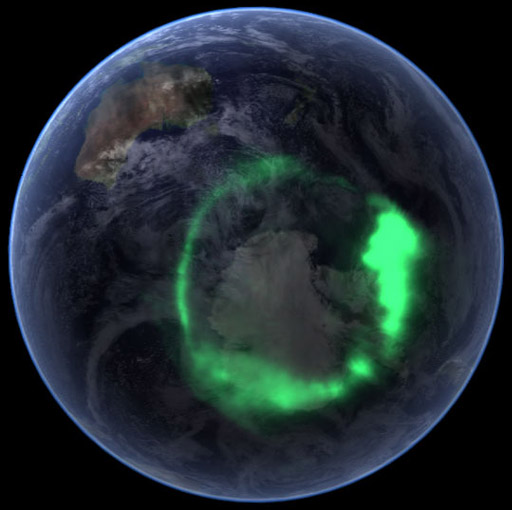Aurora at South Pole
 NASA image taken by Polar satellite, November 2004
NASA image taken by Polar satellite, November 2004
The Sun produced at least five major "halo" coronal mass ejections (CMEs) over the period of Nov. 4-8, 2004, an unusually fast pace for solar activity.The Polar spacecraft saw the aurora australis (southern lights) expanding and brightening on Nov. 8. A "halo" CME occurs when a CME produces an expanding circle of particles all around the Sun. When observers see this they know the CME is heading directly towards or away from Earth. In this case, all were headed in our direction, bringing the auroral light show with them. The source of storms was a group of sunspots called Active Region 696. The area also produced powerful solar explosions called flares.
Credit: NASA/UC Berkeley

From space, the aurora is a crown of light that circles each of EarthÕs poles. The IMAGE satellite captured this view of the aurora australis (southern lights) on September 11, 2005, four days after a record-setting solar flare sent plasmaÑan ionized gas of protons and electronsÑflying towards the Earth. The ring of light that the solar storm generated over Antarctica glows green in the ultraviolet part of the spectrum, shown in this image. The IMAGE observations of the aurora are overlaid onto NASAÕs satellite-based Blue Marble image. From the EarthÕs surface, the ring would appear as a curtain of light shimmering across the night sky.
Though scientists knew that the aurora were caused by charged particles from the Sun and their interaction with the EarthÕs magnetic field, they had no way to measure the interaction until NASA launched the Imager for Magnetopause-to-Aurora Global Exploration (IMAGE) satellite in 2000. The satelliteÕs mission was to collect data that would allow scientists to study the structure and dynamics of the EarthÕs magnetic field for the first time. Designed to operate for two years, IMAGE sent its last data to Earth in December 2005 after a highly successful five-year mission.
Since 2000, IMAGE has provided insight into how the EarthÕs powerful magnetic field protects the planet from solar winds. Without the shield the magnetic field provides, the upper atmosphere would evaporate into space under the influence of solar winds. IMAGE has shown scientists what sort of changes the magnetic field undertakes as it diverts solar winds from the Earth.
Image and description courtesy NASA
|
Index
Atmospheric optics concepts
Jupiter Concepts |




